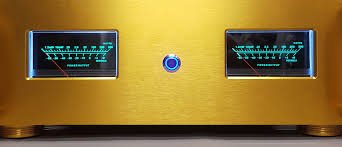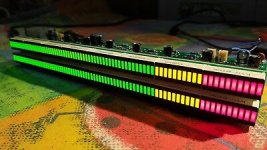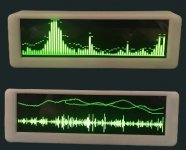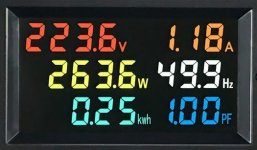I received my "built by Tom" Modulus-286 last Thursday and have been playing it a lot since then. I'll have a more detailed write-up when I've truly wrapped my head around this phenomenal amp. I don't suppose there are many folks like me at diyaudio (no DIY skills whatsoever), but suffice it to say I'm thrilled that I discovered TCA Audio and Neurochrome!
Actually would be nice to have a bit more protective padding in the open spaces. Hate to think of what happens if somebody uses the box as a makeshift ladder.A high-end amp deserves high-end packaging. The box has twice the normal wall thickness. 1/4" thick cardboard! Not cheap, but very protective.
Tom
There's over an inch of space between the (double gauge) box and the amp. You would need to ram the box with a forklift at speed to cause any damage.
The foam was designed by a company that specializes in packing foam. They're also the ones recommending the box size. They do this for a living and I trust their judgement.
Tom
The foam was designed by a company that specializes in packing foam. They're also the ones recommending the box size. They do this for a living and I trust their judgement.
Tom
Hello Forum Members
I am new in this forum and new to high quality amps. I do analogue and digital electronics since years but nothing high quality like this. Now I think about building this amp.
I read this thread from the beginning to the end and it's very interesting.
What I didn't see are any ideas about VU-Meters on the front panel. Is that something that audiophiles don't like or is it no fashion anymore or are there technical reasons why nobody in this thread (and other threads) even mentioned it.
I have something like this in mind. It might be analoge, LEDs, or even an Arduino with an OLED display. What do you think about them?
I am new in this forum and new to high quality amps. I do analogue and digital electronics since years but nothing high quality like this. Now I think about building this amp.
I read this thread from the beginning to the end and it's very interesting.
What I didn't see are any ideas about VU-Meters on the front panel. Is that something that audiophiles don't like or is it no fashion anymore or are there technical reasons why nobody in this thread (and other threads) even mentioned it.
I have something like this in mind. It might be analoge, LEDs, or even an Arduino with an OLED display. What do you think about them?
Attachments
I didn't have any DIY skills, so Tom built me a Mod-286, which I've been enjoying for several weeks and thought I'd share my experience with the amp.
In my early life, I played bass and enjoyed many types of music - hard/progressive rock, jazz, folk, pop, indie, classical, etc. For the last 30+ years, I've been through a mix of separates and integrated amps from Creek, Rega, Naim, Wyred4Sound, LFD, Aaron, Line Magnetic, Micromega, Rowland, Karan Acoustics and Audia Flight. Many were fabulous pieces of gear, but all had a distinct 'house' sound that fueled the gear churn and just didn't stick with me long-term.
The Modulus-286 is the first amp I've heard that seemingly has no character of its own, which is the highest compliment I can pay. This amp is supernaturally quiet and has tremendous clarity, without any stridency or harshness. Instrumental dynamics, pitch, timbre and nuance are easy to hear, including in the bass, which is very difficult to achieve. Every recording sounds different and the music's emotional content is easily communicated to the listener. Amazingly, there's nothing cold or clinical about this amp - Tom has managed to weave together clarity and musicality in a way I haven't heard before. To top it off, these qualities are all available at low listening levels - there's no need to turn up the amp to get this performance. Tom's build is meticulous and for me personally, I don't see needing more in an amp. If you're in the market for a completed amp that really does get out of the way and let the music speak for itself, I don't think you can go wrong with this incredible piece of gear. If you've got the DIY skills, just build one already! Very highly recommended!
In my early life, I played bass and enjoyed many types of music - hard/progressive rock, jazz, folk, pop, indie, classical, etc. For the last 30+ years, I've been through a mix of separates and integrated amps from Creek, Rega, Naim, Wyred4Sound, LFD, Aaron, Line Magnetic, Micromega, Rowland, Karan Acoustics and Audia Flight. Many were fabulous pieces of gear, but all had a distinct 'house' sound that fueled the gear churn and just didn't stick with me long-term.
The Modulus-286 is the first amp I've heard that seemingly has no character of its own, which is the highest compliment I can pay. This amp is supernaturally quiet and has tremendous clarity, without any stridency or harshness. Instrumental dynamics, pitch, timbre and nuance are easy to hear, including in the bass, which is very difficult to achieve. Every recording sounds different and the music's emotional content is easily communicated to the listener. Amazingly, there's nothing cold or clinical about this amp - Tom has managed to weave together clarity and musicality in a way I haven't heard before. To top it off, these qualities are all available at low listening levels - there's no need to turn up the amp to get this performance. Tom's build is meticulous and for me personally, I don't see needing more in an amp. If you're in the market for a completed amp that really does get out of the way and let the music speak for itself, I don't think you can go wrong with this incredible piece of gear. If you've got the DIY skills, just build one already! Very highly recommended!
zman01:
I'm using Graham Audio LS6 speakers. The bass on them can be a bit rich, which is why the Mod-286 impressed me so much in terms of bass pitch/detail. Much more expensive amps haven't been able to coax out that level of clear pitch definition and detail in the bass registers.
On an interim basis, I'm using the pre-out function of my Audia Flight FL3S integrated amp into the Mod-286. I'm waiting to see what products Tom comes out with (likely in his TCA brand) to determine next steps. Would love to see a DAC/Pre from him, but if he decides to go down the DAC only route or do nothing, I'll need to make other plans. Tom's engineering chops are a rare breed - would be great to take advantage of as many aspects of that expertise as possible. As an FYI, I also have his TCA HPA-1 headphone amp - all the same characteristics as the Mod-286.
-Mike
I'm using Graham Audio LS6 speakers. The bass on them can be a bit rich, which is why the Mod-286 impressed me so much in terms of bass pitch/detail. Much more expensive amps haven't been able to coax out that level of clear pitch definition and detail in the bass registers.
On an interim basis, I'm using the pre-out function of my Audia Flight FL3S integrated amp into the Mod-286. I'm waiting to see what products Tom comes out with (likely in his TCA brand) to determine next steps. Would love to see a DAC/Pre from him, but if he decides to go down the DAC only route or do nothing, I'll need to make other plans. Tom's engineering chops are a rare breed - would be great to take advantage of as many aspects of that expertise as possible. As an FYI, I also have his TCA HPA-1 headphone amp - all the same characteristics as the Mod-286.
-Mike
Lithium Batteries as power supply?
I am new to building amplifiers and maybe the following is a stupid idea. Please tell me what you think.
It seems everybody puts a lot of effort into the power supply of this amp (and any other powerful amp). When I understand it correct one option is a regulated switching power supply. Another option is a big transformer and a relative expensive power supply circuit.
The idea is always to get a clean, powerful and stable supply for the amp.
How about option 3, batteries?
I would think that Lithium batteries should be almost perfect as power supplies. They have no switching noise, no hum, stable voltage, and are able to supply lots of current if necessary.
This is a sample of what batteries I have in mind:
4 times ZIPPY Compact 4200mAh 4S2P 30C LiFePo4 Pack
ZIPPY Compact 4200mAh 4S2P 30C LiFePo4 Pack | HobbyKing
2 in series supply maximum 8*4.2 = 33.6V
When the battery is not full anymore it should be usable until at least 3.5V, equal to 8*3.5V = 28V
30C with 4200mAh means, at least in theory, that they can supply 30 x 4.2A = 126A constantly and even more for peak current supply.
Is all that feasible and a good idea?
Obviously an amp with batteries would only be usable for a limited time. I guess the batteries above should be able to supply power for an hour when the amp is used to the max. In real life I guess they should be able to supply the amp for at least two hours, probably more.
Obviously the batteries must be charged. But that is relative cheap and does not require a sophisticated power supply.
What do you think? Is that a crazy idea?
Part of my inspiration comes from the fact that Danny Richie from GR-Research runs his best presentation system on batteries for optimal sound quality.
I am new to building amplifiers and maybe the following is a stupid idea. Please tell me what you think.
It seems everybody puts a lot of effort into the power supply of this amp (and any other powerful amp). When I understand it correct one option is a regulated switching power supply. Another option is a big transformer and a relative expensive power supply circuit.
The idea is always to get a clean, powerful and stable supply for the amp.
How about option 3, batteries?
I would think that Lithium batteries should be almost perfect as power supplies. They have no switching noise, no hum, stable voltage, and are able to supply lots of current if necessary.
This is a sample of what batteries I have in mind:
4 times ZIPPY Compact 4200mAh 4S2P 30C LiFePo4 Pack
ZIPPY Compact 4200mAh 4S2P 30C LiFePo4 Pack | HobbyKing
2 in series supply maximum 8*4.2 = 33.6V
When the battery is not full anymore it should be usable until at least 3.5V, equal to 8*3.5V = 28V
30C with 4200mAh means, at least in theory, that they can supply 30 x 4.2A = 126A constantly and even more for peak current supply.
Is all that feasible and a good idea?
Obviously an amp with batteries would only be usable for a limited time. I guess the batteries above should be able to supply power for an hour when the amp is used to the max. In real life I guess they should be able to supply the amp for at least two hours, probably more.
Obviously the batteries must be charged. But that is relative cheap and does not require a sophisticated power supply.
What do you think? Is that a crazy idea?
Part of my inspiration comes from the fact that Danny Richie from GR-Research runs his best presentation system on batteries for optimal sound quality.
With batteries you replace a pretty simple circuit (transformer, rectifier, capacitors) with a complicated charger and battery chemistry. Depending on where the battery is on its discharge curve, the output impedance of the battery could be higher than that of a power supply.
You'd need 14 batteries to create ±28-30 V.
But yeah... It could be done. One could also entertain the thought of using batteries from portable tools. Some of them have pretty serious capacity.
Tom
You'd need 14 batteries to create ±28-30 V.
But yeah... It could be done. One could also entertain the thought of using batteries from portable tools. Some of them have pretty serious capacity.
Tom
Thanks Tom
with the 4S battery packs which I mentioned above 4 of those would be necessary. All 4 together cost about 200USD.
You are the developer of this amp so I am sure you will be able to answer this: Would the sound quality with batteries be better than with any mains connected power supply?
And if not, why not? Or is it maybe measurable but not audible?
with the 4S battery packs which I mentioned above 4 of those would be necessary. All 4 together cost about 200USD.
You are the developer of this amp so I am sure you will be able to answer this: Would the sound quality with batteries be better than with any mains connected power supply?
And if not, why not? Or is it maybe measurable but not audible?
Thanks Tom
can you please explain a little how that error correction works. Or maybe you have a link to a place where you explained it already.
I know you develop high quality products and it is not my intention to doubt what you say. I just want to understand it.
Because as far as I understand unregulated power supplies like i.e. your Power-86 and others don't supply a steady voltage especially if the amp demands a lot of power.
I.e. if the amp does not demand much power then maybe the output voltage will vary between maybe 36.00V and 36.01V - just as an example.
But when the amp demands a lot of power then, as far as I know, the output voltage of the power supply will vary more. I.e. 100mV or even more difference with 100Hz frequency.
Is that correct?
Why does that difference in the input voltage of the amp not matter?
And what would be a value (ripple?) that would matter? I.e. 500mV or how much would be acceptable for your amp?
It would be great if you can explain this a little. I like to learn how this works.
Thanks
can you please explain a little how that error correction works. Or maybe you have a link to a place where you explained it already.
I know you develop high quality products and it is not my intention to doubt what you say. I just want to understand it.
Because as far as I understand unregulated power supplies like i.e. your Power-86 and others don't supply a steady voltage especially if the amp demands a lot of power.
I.e. if the amp does not demand much power then maybe the output voltage will vary between maybe 36.00V and 36.01V - just as an example.
But when the amp demands a lot of power then, as far as I know, the output voltage of the power supply will vary more. I.e. 100mV or even more difference with 100Hz frequency.
Is that correct?
Why does that difference in the input voltage of the amp not matter?
And what would be a value (ripple?) that would matter? I.e. 500mV or how much would be acceptable for your amp?
It would be great if you can explain this a little. I like to learn how this works.
Thanks
- Home
- Vendor's Bazaar
- Neurochrome Modulus-286: 65W (8Ω); 125W (4Ω) @ <-120dB THD Composite Amplifier Module



